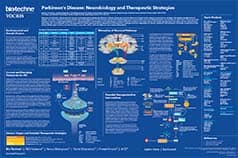Monoamine Oxidases
Monoamine Oxidases (MAO) catalyze the oxidation of monoamines such as dopamine, serotonin and adrenalin. They are found bound to the outer membrane of mitochondria in most cell types in the body. Two subtypes of MAO have been identified: MAO-A and MAO-B.
Monoamine Oxidase Inhibitors |
|
|---|---|
| Cat. No. | 产品名称/活性 |
| 2460 | Lazabemide hydrochloride |
| Selective MAO-B inhibitor | |
| 4395 | Moclobemide |
| Reversible MAO-A inhibitor | |
| 4308 | Rasagiline mesylate |
| Selective and irreversible MAO-B inhibitor | |
| 3852 | Tranylcypromine hydrochloride |
| Irreversible and non-selective MAO inhibitor; also inhibits LSD1 | |
Monoamine Oxidases (MAO) catalyze the oxidation of monoamines such as dopamine, serotonin and adrenalin. They are found bound to the outer membrane of mitochondria in most cell types in the body. Two subtypes of monoamine oxidase have been identified: MAO-A and MAO-B. Both are found in neurons and astroglia, with MAO-A also found in the liver, gastrointestinal tract and placenta and MAO-B in blood platelets. Abnormal regulation of MAOs in the body has been associated with depression, substance abuse, attention deficit disorder, and irregular sexual maturation.
External sources of pharmacological information for Monoamine Oxidases :
Literature for Monoamine Oxidases
Tocris offers the following scientific literature for Monoamine Oxidases to showcase our products. We invite you to request* your copy today!
*Please note that Tocris will only send literature to established scientific business / institute addresses.
Addiction Poster
The key feature of drug addiction is the inability to stop using a drug despite clear evidence of harm. This poster describes the brain circuits associated with addiction, and provides an overview of the main classes of addictive drugs and the neurotransmitter systems that they target.
Depression Poster
Major depressive disorder is characterized by depressed mood and a loss of interest and/or pleasure. Updated in 2015 this poster highlights presynaptic and postsynaptic targets for the potential treatment of major depressive disorder, as well as outlining the pharmacology of currently approved antidepressant drugs.
Parkinson's Disease Poster
Parkinson's disease (PD) causes chronic disability and is the second most common neurodegenerative condition. This poster outlines the neurobiology of the disease, as well as highlighting current therapeutic treatments for symptomatic PD, and emerging therapeutic strategies to delay PD onset and progression.


